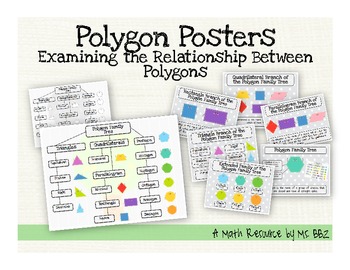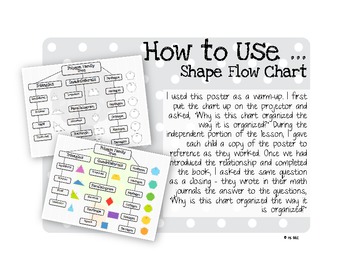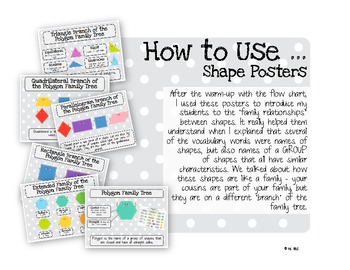Polygon Posters: Classification of 2D Shapes {G.A.1 - Common Core Aligned}
Ms BBZ
1.1k Followers
What educators are saying
The variety and feasibility to use this resource with all kinds of learners is what makes this a great resource. Thank you.
Description
This resource is a set of posters meant to help your kids understand how we classify shapes into categories based on their attributes.
For example - there are triangles that share attributes (three sides and angles), but there are also three different KINDS of triangles (scalene, right, isosceles, and equilateral). Another example might be that that a square can be classified as a rectangle because it has four sides and four right angles.
If you want your students to stop using descriptions like, "stretched out square" to describe a rectangle, and instead use vocabulary like sides, angles, parallel, etc. - this is a wonderful resource.
I have included both a color and black and white copy for easier printing.
You might be interested in saving money by purchasing this as a BUNDLED unit:
CLICK HERE: Polygon Family Tree
OR the Polygon Posters
CLICK HERE: Polygon Scrapbook
This product provides practice for the following Common Core Standards:
1.G.A.1
2.G.A.1
3.G.A.1
For example - there are triangles that share attributes (three sides and angles), but there are also three different KINDS of triangles (scalene, right, isosceles, and equilateral). Another example might be that that a square can be classified as a rectangle because it has four sides and four right angles.
If you want your students to stop using descriptions like, "stretched out square" to describe a rectangle, and instead use vocabulary like sides, angles, parallel, etc. - this is a wonderful resource.
I have included both a color and black and white copy for easier printing.
You might be interested in saving money by purchasing this as a BUNDLED unit:
CLICK HERE: Polygon Family Tree
OR the Polygon Posters
CLICK HERE: Polygon Scrapbook
This product provides practice for the following Common Core Standards:
1.G.A.1
2.G.A.1
3.G.A.1
Total Pages
10 pages
Answer Key
N/A
Teaching Duration
N/A
Report this resource to TPT
Reported resources will be reviewed by our team. Report this resource to let us know if this resource violates TPT’s content guidelines.
Standards
to see state-specific standards (only available in the US).
CCSS2.G.A.1
Recognize and draw shapes having specified attributes, such as a given number of angles or a given number of equal faces. Identify triangles, quadrilaterals, pentagons, hexagons, and cubes.
CCSS3.G.A.1
Understand that shapes in different categories (e.g., rhombuses, rectangles, and others) may share attributes (e.g., having four sides), and that the shared attributes can define a larger category (e.g., quadrilaterals). Recognize rhombuses, rectangles, and squares as examples of quadrilaterals, and draw examples of quadrilaterals that do not belong to any of these subcategories.





